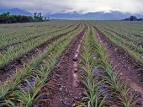 |
| Pineapple on a farm |
🌿 Why Pineapple?
Pineapple is packed with vitamins A, B, and C and minerals like calcium, magnesium, potassium, and iron. It also contains bromelain, a powerful digestive enzyme known for its anti-inflammatory properties.
Apart from being consumed fresh, pineapples are widely used in the canning, juicing, and food processing industries.
With global annual production reaching 14.6 million tonnes, India ranks fifth in pineapple production with about 1.2 million tonnes per year.
☀️ 1. Suitable Climate for Pineapple Farming
Pineapple thrives in humid tropical regions with moderate temperatures and ample rainfall.
-
Optimum rainfall: 1500 mm annually (but it can tolerate 500–5500 mm)
-
Ideal temperature range: 15.5°C – 32.5°C
-
Altitude: Up to 1525 m above sea level
-
Avoid: Frost, extreme cold, and total shade
Interestingly, pineapple grows well both near coastal areas and inland regions, as long as drainage is good and temperatures remain moderate.
 |
| Pineapple farm |
🌱 2. Suitable Soil for Pineapple Farming
Pineapple adapts to various soil types, but well-drained, slightly acidic soil produces the best yields.
-
Ideal pH: 5.5–6.0
-
Best soils: Sandy loam, lateritic, or alluvial soils
-
Avoid: Heavy clay or waterlogged soils
Proper soil aeration ensures healthy root growth and prevents diseases like stem rot.
🧑🌾 3. Land Preparation
Prepare the land by plowing and leveling to achieve uniform beds.
Depending on the land type:
-
Create trenches about 90 cm wide and 15–30 cm deep
-
Ensure good drainage to prevent water stagnation
🌦️ 4. Best Season for Planting
Pineapple grows well both in plains and at elevations below 900 m. It cannot tolerate frost or extreme heat.
-
Flowering period: February–April
-
Harvesting period: July–September
-
Off-season harvest: September–December (in some areas)
🍀 5. Planting Material
Pineapple is propagated using suckers, slips, or crowns.
-
Suckers and slips: Bear flowers after 12 months
-
Crowns: Bear flowers after 19–20 months
-
Tissue-cultured plants are also available for uniform and disease-free cultivation.
🌾 6. Plant Spacing & Density
For commercial cultivation, high-density planting ensures maximum yield.
| Condition | Recommended Density | Spacing (cm) |
|---|---|---|
| Subtropical/mild humid | 63,400 plants/ha | 22.5 × 60 × 75 |
| Hot & humid | 53,300 plants/ha | 25 × 60 × 90 |
| Rainfed hilly areas | 31,000 plants/ha | Variable |
🌱 7. High-Density Planting Benefits
-
Higher yields (70–105 tonnes/ha)
-
Less weed growth
-
Reduced sunburn damage
-
Better plant stability (prevents lodging)
-
Increased sucker and slip production
🌿 8. Planting Methods
Four main systems are used:
-
Flatbed
-
Furrow
-
Contour
-
Trench
In hilly or sloped areas, contour or terraced planting helps control soil erosion.
🔄 9. Intercultural Operations
-
Earthing up: Strengthens plant anchorage and prevents lodging.
-
Weeding: Regular removal ensures healthy growth.
-
Mulching: Retains soil moisture and suppresses weeds.
In high-density systems, lodging is minimized as plants naturally support each other.
💧 10. Irrigation Management
Pineapple is mostly rain-fed, but supplementary irrigation is beneficial during dry spells.
-
Frequency: Every 20–25 days during dry weather
-
Benefit: Ensures uniform fruit size and enables off-season planting
🐛 11. Pest & Disease Management
Pineapple is relatively pest-resistant.
However, mealybugs and scale insects can occasionally cause problems.
Stem rot may occur due to poor drainage.
Preventive measures:
-
Ensure good drainage
-
Dip suckers in Bordeaux mixture before planting
🌾 12. Manure & Fertilizer Management
Pineapple has high nitrogen and potassium needs but shallow roots.
-
Per plant: 12 g N, 12 g K₂O, and (if needed) 4 g P₂O₅
-
Nitrogen: Apply in 6 split doses (from 2 to 12 months after planting)
-
Potassium: Split into 2 doses
-
Apply fertilizers when soil moisture is adequate (especially under rainfed conditions).
🍍 13. Harvesting & Yield
-
Flowering: 12–15 months after planting
-
Maturity: 15–18 months after planting
-
Harvest window: May–August
-
Ripening: ~5 months after flowering
To ensure uniform flowering, apply Ethrel (100 ppm) one month before expected bloom.
🧺 14. Post-Harvest & Ratooning
-
For canning: Harvest when the base starts changing color
-
For the fresh market: Wait until the fruits turn golden yellow
-
Ratoon crops: Maintain for 3–4 years (yield declines with each cycle)
-
Average yield: 50–80 tonnes/ha, depending on management practices
After about 5 years, replant the entire plot for sustained productivity.
💰 15. Marketing & Profitability
Pineapples enjoy strong domestic and international demand.
They are sold fresh or processed into:
-
Canned slices & tidbits
-
Pineapple juice & concentrate
-
Dried fruit and jams
Value addition and export potential make pineapple farming a profitable agribusiness opportunity.
 |
| Freshly cut pineapple fruits |
🌴 Final Thoughts
With proper climate, soil management, and high-density planting, pineapple farming can deliver exceptional yields and steady income. Whether you are a smallholder farmer or a commercial grower, pineapples offer a sustainable and rewarding cultivation venture.
Comments
Post a Comment